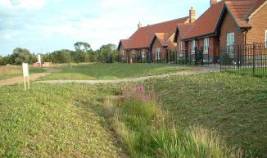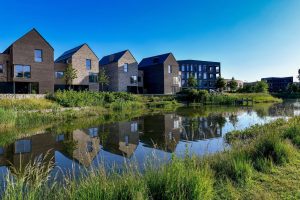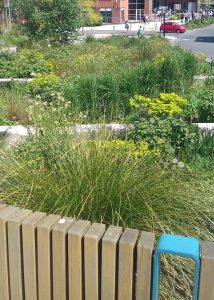When it comes to developing a site, drainage is typically considered a ‘form-over-function’ mechanism for transporting rainwater away as quickly as possible, and often drainage solutions are simply installed underground and forgotten about.
Drainage, however, doesn’t have to be just about moving water – it can increase site value, reduce capital costs, and look great too and while many developers, architects, and planners are well aware of the aesthetic possibilities good drainage can bring, when designed correctly it can also provide financial benefits for both the developer and the end-user.
This week the Rennard Consulting Blog will be focusing on how drainage design can save you money on a site, increase its value and even have some financial benefits for the people that will live eventually live and work there.
So how can drainage save you money?
You may have seen from our previous posts how innovative, sustainable drainage design is not only effective in transporting water off-site but can also improve the places and spaces where we live and work.
It may come as a surprise therefore that it can also increase the value of a site, which in turn can maximise your potential profits and while planning and installing a decent drainage system is a mandatory step in every development, depending on the solution you choose there are opportunities to save money on your overall project costs.
A great example of this in action is the Lamb Drove residential development which is owned by the Cambridge Housing Society[1]. In this project, by installing a Sustainable Drainage System they reported estimated cost savings of approximately £11k when compared with traditional methods; which was partly down to a reduction in excavation costs.
Figure 1: Lamb Drove SuDS Scheme

Source: https://www.susdrain.org/case-studies/case_studies/lamb_drove_residential_suds_scheme_cambourne.html
Furthermore, it was estimated that costs to sustain the solution worked out at £38/per property, per year which was 4% cheaper than the average equivalent for a traditionally drained system.
Blue and green space can also boost a site’s commercial value
Drainage can have the potential to enrich the aesthetic and recreational value of any development, promoting well-being and supporting green infrastructure.
This is especially pertinent following the pandemic as there has been a shift in the demands of UK buyers and investors towards natural, biophilic spaces in and around residential sites.
This was shown in the August 2020 RICS UK Residential Survey[2], where 79% of professionals surveyed relayed a rising demand for properties near green space. In addition, according to the ONS, data from one million property sales within urban areas in England and Wales between 2009 and 2016 indicates that people are prioritising green and blue space[3].
Figure 2: Example of Residential Development near Water

It was also estimated that having a view over a green space or water (such as lakes, rivers or canals) boosted house prices by an extra 1.8% – an average of £4,600. Despite this 25.7% of properties currently do not have any blue space site within a 500 metres radius, while 6.4% have zero access to public green sites.
Sustainable drainage can also create £millions in benefits
While I know we have discussed this project before, a brilliant example of how drainage increases the value of a site is the Greener Grangetown Project[4] in Cardiff.
Alongside installing sustainable drainage solutions that remove an average of 40,000m3 of surface runoff from the combined sewer system annually, in this project developers ensured their end-users could enjoy the aesthetic benefits of such a design.
Looking at the financial side, in 2019 an assessment was carried out for the project using the CIRIA’s Benefit Estimation Tool (B£ST), which focused on aspects like health, recreation, air quality improvements, carbon sequestration, and amenity enhancements. It reported an estimated benefit of approximately £8.4 million over a 30 year period from 2015 to 2045, with a maximum estimated payback period of 12.5 years.
The project represents incredible value for money – all thanks to how they used their drainage solution to maximise the benefits.
Good drainage can also reduce costs for end-users
All this is great news for design teams, but there are also financial benefits that can be passed on to your end-users.
For new developments, if residents can demonstrate that their surface water drainage does not connect to nor rely on public sewers they could be entitled to a reduction in their water bill, which given the current rise in living cost can only be a good thing.
We can also reduce the costs associated with flooding through the use of properly thought out drainage systems and the use of SuDS, which slow the flow of water through a site and decreasing the amount of runoff generated. On the Susdrain website, there is a great example of three Scottish SuDS schemes where the peak flow of surface water runoff was at least 50% lower than traditional drainage for a neighbouring site.
Boosting local economic growth
SuDS can even impact the local economy of a residential and/or commercial site with the Sheffield Grey to Green project[5] being a great example of this.
Here, the city of Sheffield transformed its Riverside Business District from a redundant road space into flower meadows and wetlands, using newly planted areas as landscapes to manage the rainwater off the road in an interlinked sustainable drainage system.
Figure 3: Sheffield Grey to Green

Not only does it look great[6], but there is sustained hope that residents and businesses will enjoy an economic boost. There is even some evidence that shows shoppers are willing to travel longer distances to business districts with trees[7], staying longer and returning with more frequency.
Summary
Through this post, we have tried to demonstrate how well-designed drainage systems can bring a variety of financial benefits to both the developer and the end-user and while the evidence is building to show the short-term, positive effects on profit (such as reduced construction costs) more needs to be done to demonstrate some of the other potential financial benefits such as a reduction in crime rates and potentially increase in sales values of properties.
Either way, it is exciting to think that there are drainage solutions out there that are as easy on the eyes as they are on profits margins.
Either way, it is exciting to think that there are drainage solutions out there that are as easy on the eyes as they are on profits margins.
References
[1] https://www.susdrain.org/case-studies/case_studies/lamb_drove_residential_suds_scheme_cambourne.html
4 https://www.susdrain.org/case-studies/pdfs/greener_grangetown_case_study_lightv2.pdf
5 http://www.greytogreen.org.uk/suds.html
6https://www.nigeldunnett.com/grey-to-green-2/
7https://www.susdrain.org/delivering-suds/using-suds/benefits-of-suds/Economic-growth